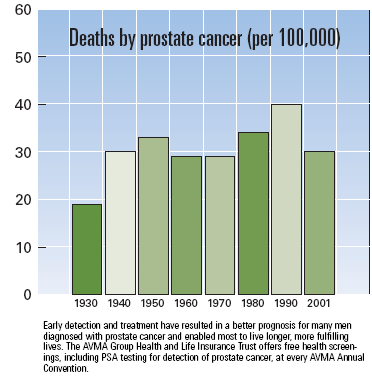Link between exercise and lower risk for prostate cancer found
|
The findings of the study were announced May 9 by researchers at the Harvard School of Public Health. Researchers analyzed data compiled during a 14-year period from a study of 47,620 male physicians, dentists, optometrists, podiatrists, pharmacists, and veterinarians, ages 40 to 75 years. Specifically, the researchers were assessing any relationship between vigorous activity and the risk of advanced prostate cancer in older men. While no association was observed in men younger than 65, the statistics for older men were quite impressive. In subjects 65 and older, researchers found that men in the highest category of vigorous activity had a risk that was almost 70 percent lower for advanced and for fatal prostate cancer. Vigorous activity was defined as at least three hours per week spent on such activities as jogging, biking, swimming, tennis, racquetball, squash, rowing, calisthenics, heavy outdoor work, and weight training. The report does not draw any firm conclusions as to why or how physical activity may provide protection, but it does note that physical activity might influence some hormones—including insulin-like growth factor 1, insulin, leptin, and testosterone—that are thought to enhance prostate cancer carcinogenesis. Physical activity has been prescribed as a sound precautionary measure for most kinds of cancer. This is the first study that has found a direct link between exercise and a lowered risk for prostate cancer. Prostate cancer is the second most common type of cancer found in American men, with skin cancer being the most prevalently diagnosed cancer. The American Cancer Society estimates more than 232,000 new cases of prostate cancer will be diagnosed in the United States in 2005. About 30,350 men will die of the disease this year alone. In fact, prostate cancer is the second leading cause of cancer death in men, second only to lung cancer. While one in six men will get prostate cancer during his lifetime, only one in 34 will die of the disease. Moreover, the death rate for prostate cancer has decreased in recent years. Early detection and treatment have resulted in a better prognosis for many men diagnosed with prostate cancer, enabling most to live longer, more fulfilling lives. The AVMA Group Health and Life Insurance Trust offers free health screenings, including prostate-specific antigen testing for detection of prostate cancer, at every AVMA Annual Convention. The PSA test is offered to men over age 40, including male AVMA members and husbands of members. During the 2004 convention in Philadelphia, 161 men were provided PSA tests for detection of prostate cancer. At the 2005 convention in Minneapolis, 516 men took advantage of the free test. The test is available to older members because age is a primary factor in the occurrence of prostate cancer. A man's odds of being diagnosed with prostate cancer increases the older he gets. The experience of AVMA GHLIT members corroborates this fact. In a recent 12-month period, the AVMA GHLIT paid out more than $759,000 in prostate cancer claims. Of the 1,545 men filing claims, a little more than 62 percent of those men were 65 or older. These figures are in line with national statistics provided by the American Center Society, which indicate that in the general population, about two out of every three prostate cancers are found in men above the age of 65. While the Harvard study does not draw a correlation between vigorous exercise and a reduced risk of prostate cancer for men younger than 65, a prescription to be active is still sound medical advice and might pay off in protection in later years. Anyone beginning a new exercise regimen—particularly older individuals—a physical check-up and a chat with one's physician is the best way to start. Regular screenings also increase the odds of detecting cancer earlier, when treatment is often easier, and survival rates are higher. The AVMA GHLIT has an upgraded Wellness Benefit on many plans to encourage veterinarians to be more proactive about their health. For more information on the AVMA GHLIT, call (800) 621-6360 or visit www.avmaghlit.org. | ||
 A recent study, which included many male veterinarians, concluded that a robust regimen of exercise could slow the progress of prostate cancer and reduce deaths directly associated with the disease among older patients.
A recent study, which included many male veterinarians, concluded that a robust regimen of exercise could slow the progress of prostate cancer and reduce deaths directly associated with the disease among older patients.